Greek Easter Lamb Roast Part I
 Vegetarians beware. This is gonna get ugly. (For the rest of you, though, I've gotta say, I did it and I'll do it again!)
Vegetarians beware. This is gonna get ugly. (For the rest of you, though, I've gotta say, I did it and I'll do it again!)It started out really very civilized. We walked through downtown Geneva Switzerland to get to a friend's house. Met the in-laws there. Sipped a Saturday-afternoon Jasmine tea together in Michelle and Bertrand's lovely, lovely Geneva kitchen. Crunched ginger snaps. Engaged in polite conversation. Regarded each other in the calmest of manners.
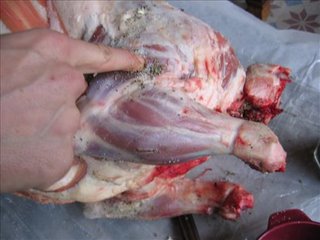 Then barbary set in. You see, we didn't come to sip tea; we came to turn a lamb into dinner. So there it is, I said it. After all this isn't something people haven't been doing for thousands of years. We have tradition on our side. And hunger.
Then barbary set in. You see, we didn't come to sip tea; we came to turn a lamb into dinner. So there it is, I said it. After all this isn't something people haven't been doing for thousands of years. We have tradition on our side. And hunger. In fact ever since meeting Gabriel in March of 2000, I have participated in at least seven or eight lamb roasts. When we lived in Minneapolis, Gabriel actually had a 5-foot spit made by an iron worker, an artisan really, judging by the way he rendered Gabriel's drawings into metal. So in Minnesota, Gabriel is known for his big back-yard lamb roasts whether it be to celebrate Greek Easter or just an excuse for an extended get-together. Now that we live in Italy, the Greek Easter celebrations take place at Michelle and Bertrand's house because they are the only ones we know who have a yard.
So here you'll get a primer on preparing a whole lamb for slow back-yard barbecuing. Our lamb weighed in at 16 kilos (35 lbs) and was skinless and whole minus head and hooves. The day before cooking, we prepared it with a kind of dry rub and let the lamb absorb the flavors overnight.
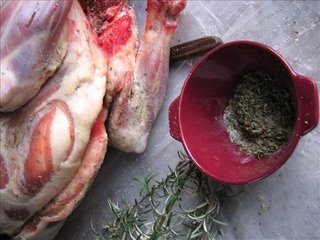 Greek Lamb Dry rub:
Greek Lamb Dry rub:1/2 cup Greek oregano
1/4 cup salt
1/4 cup white pepper
1-1/2 heads garlic
1-35lb lamb
*Optional fresh rosemary sprigs
Equipment:
1 5-foot long spit with 2 supports
12 gauge wire
pair of pliers
20 feet of plastic wrap
Greeks do a dry rub like this: Put the oregano, salt and pepper in a bowl and reserve, then peel the garlic and slice the cloves longways into spikes. That means quartering the smaller cloves and cutting the larger ones into six long spears. With a very sharp knife, pierce the meat laterally, that is don't make a cut into the meat going toward the bone, but make the cut parallel to the skin. Take a pinch of the spice mixture with your fingers and insert it into the hole. (See photo above). And 5 minutes ago, you were just sipping tea! This process really brings home the symbolism of Christ, Lamb of God and all, except that YOU'RE the Roman soldier. Then take a garlic spike and insert it into the same hole. Make another hole about 4 inches away and repeat the process. Once you have spiked the whole beast with garlic and spices, rub the remaining spice mixture all over the meat and into the cavity. If you like you can put a few rosemary sprigs into the cavity as well.
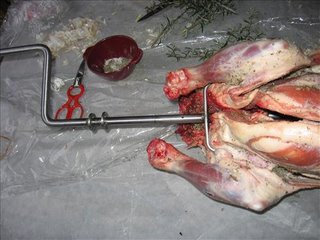
Now it's time to tie the lamb to the stake. Ugh, sorry, more Jesus references. Before writing this, I never really made that connection. You must have a metal spit for this. The spit goes through the neck, through the body cavity and out the end. Two pinchers on each end pierce the meat at the shoulders and tops of the legs. You must secure the lamb better than that though if you want it to keep turning for 6 hours over the fire. You must take 3 12-inch long lengths of wire and thread them from the inside of the cavity around the spit and through to the back of the lamb, encasing the spit and the spinal cord.
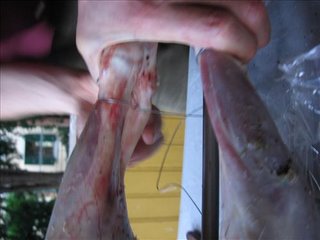 Twist the ends of the wire with a pair of pliers very tightly so that the lamb will be secure against the spit. Then take another foot-long stretch of wire and wrap it tightly around one of the ankles then bring the wire under the spit and wrap the other ankle joint. Then you will pull the wire tightly and tie by twisting the two wire ends together with the pliers. This is similar to what you do to truss a turkey. Do the same thing with the fore legs.
Twist the ends of the wire with a pair of pliers very tightly so that the lamb will be secure against the spit. Then take another foot-long stretch of wire and wrap it tightly around one of the ankles then bring the wire under the spit and wrap the other ankle joint. Then you will pull the wire tightly and tie by twisting the two wire ends together with the pliers. This is similar to what you do to truss a turkey. Do the same thing with the fore legs. 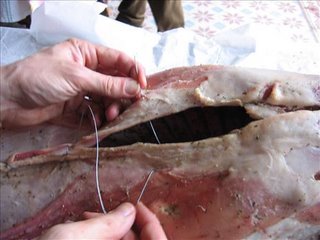 Finally it is time to close up the cavity. Music to stitch lamb by: Chicago Sub Pop favorite, Red Red Meat. Well, what were you expecting, chamber music? You will take a 2 foot-long stretch of wire and "sew" up the two sides of the vertical cut at the abdomen. To secure the first stitch, run the wire through the two sides of the belly cut and pull almost all the way through. Bend the end piece up and twist it around the piece coming out the other side to make a closed loop. Then continue to "sew" up to the top and make a final loop at the top as well.
Finally it is time to close up the cavity. Music to stitch lamb by: Chicago Sub Pop favorite, Red Red Meat. Well, what were you expecting, chamber music? You will take a 2 foot-long stretch of wire and "sew" up the two sides of the vertical cut at the abdomen. To secure the first stitch, run the wire through the two sides of the belly cut and pull almost all the way through. Bend the end piece up and twist it around the piece coming out the other side to make a closed loop. Then continue to "sew" up to the top and make a final loop at the top as well.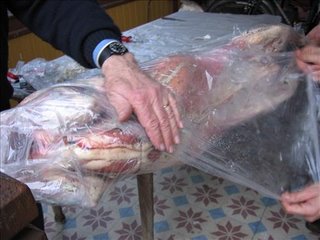 Now you're ready to store the lamb. The easiest way to wrap it in the plastic is to have a team of three people. Two hold the ends of the spit and slowly turn while the third guides the plastic to smoothly wrap everything without any bare spots. Now, you Americans can place the whole lamb in your enormous refrigerators. The rest of you can put the lamb unrefrigerated in a basement or garage. I have eaten many lambs that had stayed out all night w/o refrigeration and I have never gotten sick. The 6 hours of cooking the next day seem to take care of that. Well folks, that's that for today. Tune in tomorrow for Easter Sunday cooking tips. And more pictures, of course.
Now you're ready to store the lamb. The easiest way to wrap it in the plastic is to have a team of three people. Two hold the ends of the spit and slowly turn while the third guides the plastic to smoothly wrap everything without any bare spots. Now, you Americans can place the whole lamb in your enormous refrigerators. The rest of you can put the lamb unrefrigerated in a basement or garage. I have eaten many lambs that had stayed out all night w/o refrigeration and I have never gotten sick. The 6 hours of cooking the next day seem to take care of that. Well folks, that's that for today. Tune in tomorrow for Easter Sunday cooking tips. And more pictures, of course.
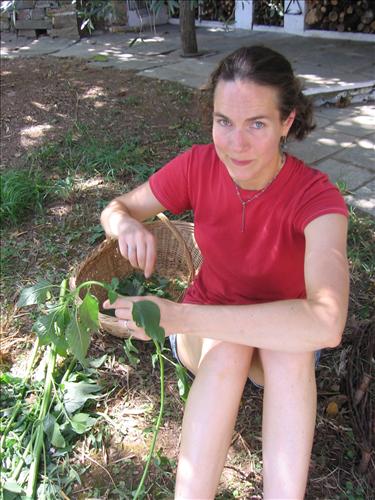

13 Comments:
oh you have more guts than me! the only thing missing from the poor lamb cadaver at his parents' house were the hooves (sp?). the head was still attached, then in front of me, very unceremoniously chopped.
i can't wait to hear about the rest!
Tracie, So did you (or they) eat the brain, cheek and tongue? In Greece you would and you buy the whole lamb with head and entrails, but no hooves. (I think that's the right spelling) Then while you're doing the nasty garlic poking, somebody's making "mayeritsa" soup out of the entrails for midnight Easter vigil dinner. In Switzerland they passed a law prohibiting the sale of the animal with innards so we had to make due with chicken livers, kidneys and gizzards. Even the kids ate them! I was impressed (as in, "mi da impressione").
holy toledo, susan. and i was all proud of myself on easter for roasting a duck.
again, you're taking me back to spain. my husband and i ordered the 'house specialty' goat's foot stew. when it came out of the kitchen-- whole hooves complete with hairs in broth-- we got such a serious case of the giggles we had to take deep breaths to avoid insulting the owner! i'd post the photo we took, but have no idea how to post photos on comments.
looking forward to part 2!
oh good god no. i am even less a fan of entrails and brains and toungues and things than i am of mayonnaise...
Hi Susan!
I just found your blog through Haalo's site and I'm so glad that I did!
I love it! I'll be visiting often!
Susan! I loved this post - I was fascinated by the process and can't wait to read part 2. I know for our engagement they (the family and lots of help) roasted a pigling (they call it "letao" in India) but as I was the blushing bride-to-be I wasn't really involved in the process! :)
Hello Melissa, Yes. Spain trumps every other country I've ever been to for food-challenge fervor. Brains and bull testicles as normal meals. I love the markets that display circles of fish each biting the tail of the one in front and the stalls with whole hog's heads hanging by hooks in the mouth. The whole jamon serranos (prosciuttos) hanging above one's head in bars with little drip cones so the rendering fat doesnt fall on top of you. The hair on the hooves, though seems a little daunting. Was it tasty? and BTW if I had to roast this whole lamb myself, well, I'd roast a duck for easter. Did you save the fat? It's supposed to be heavenly delicious.
Ivonne, Hello, thanks for stopping by. I've visited your blog a number of times, Cream Puffs in Venice, yum!
Lotus, Ooh! A whole roasted pig. Did you have a traditional wedding? The pig was probably at least twice the size of this lamb. Even when they're young they're surprisingly big. The term "letao" might even come from Portuguese, and similar to the Spanish "lechon". Do you come from anywhere near Goa by any chance?
Absolutely Fantastic! Just love seeing these types of traditions celebrated. Wonderful photos too!
Hi, Susan!
Yes, you must be right! Letao does probably come from the Portuguese. My husband's family is from Mangalore originally (but several generations ago they were converted to Catholicism by the Portuguese) and many of them took Portuguese surnames as well.
My family is from the North of India -Punjab.
Lotus, Oh, so that's how you get a roast pig for the pre-wedding celebration, Catholicism:D I used to think D'Souza was an Indian name (and indeed now it is!) but I didn't know it came from Portugal.
Yes, indeedy! D'Souza is a very common Indian-Catholic name :) You will also hear a lot of names like Dias or Diaz, Almeida, Furtado, Gomez and so on! My mother-in-law's maiden name was "Rebello".
I was impressed to see your food served. lamb is a very good meal. Everyone likes it. In an Indian Restaurant in Geneva , I ate many types of lamb recipes. You can come if you want.
Post a Comment
<< Home